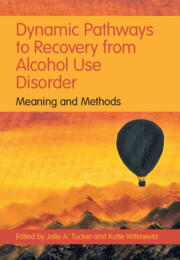Book contents
- Dynamic Pathways to Recovery from Alcohol Use Disorder
- Dynamic Pathways to Recovery from Alcohol Use Disorder
- Copyright page
- Dedication
- Contents
- Figures
- Tables
- Contributors
- Foreword
- Preface
- Acknowledgments
- Introduction
- Part I Micro Level
- Part II Meso Level
- 9 Natural Recovery from Alcohol Use Disorder
- 10 Individual Behavioral Interventions to Incentivize Sobriety and Enrich the Natural Environment with Appealing Alternatives to Drinking
- 11 Family and Social Processes in Recovery from Alcohol Use Disorder
- 12 Community-Based Harm Reduction Approaches for Alcohol Use Disorder
- 13 Use of Mobile Technology to Understand and Improve Recovery from Alcohol Use Disorder
- 14 Studying Recovery in the Social Context
- 15 Measuring Substance Use Contexts and Substance-Free Reinforcement
- Part III Macro Level
- Conclusions and Future Directions
- Index
- References
15 - Measuring Substance Use Contexts and Substance-Free Reinforcement
from Part II - Meso Level
Published online by Cambridge University Press: 23 December 2021
- Dynamic Pathways to Recovery from Alcohol Use Disorder
- Dynamic Pathways to Recovery from Alcohol Use Disorder
- Copyright page
- Dedication
- Contents
- Figures
- Tables
- Contributors
- Foreword
- Preface
- Acknowledgments
- Introduction
- Part I Micro Level
- Part II Meso Level
- 9 Natural Recovery from Alcohol Use Disorder
- 10 Individual Behavioral Interventions to Incentivize Sobriety and Enrich the Natural Environment with Appealing Alternatives to Drinking
- 11 Family and Social Processes in Recovery from Alcohol Use Disorder
- 12 Community-Based Harm Reduction Approaches for Alcohol Use Disorder
- 13 Use of Mobile Technology to Understand and Improve Recovery from Alcohol Use Disorder
- 14 Studying Recovery in the Social Context
- 15 Measuring Substance Use Contexts and Substance-Free Reinforcement
- Part III Macro Level
- Conclusions and Future Directions
- Index
- References
Summary
Research on addictive behavior change has highlighted the importance of assessing and monitoring contextual features surrounding substance use. This chapter summarizes contextual, substance-involved, and substance-free measurement procedures that are used in human research and practice. These measures are guided by behavioral economic theory and comprise techniques to assess the interaction of the environment and the person, including aspects of enjoyment and contextual situations associated with drug-taking, rating scale measures of drug and drug-free rewards, and relative reinforcement value measures. The approaches summarized demonstrate the importance of focusing on substance use contexts, the behavioral economic factors that support continued substance use, and the availability of substance-free reinforcement. These factors should be an integral feature of substance-related assessment and interventions to reduce harmful substance use and promote recovery from alcohol and other substance use disorders.
Keywords
- Type
- Chapter
- Information
- Dynamic Pathways to Recovery from Alcohol Use DisorderMeaning and Methods, pp. 280 - 300Publisher: Cambridge University PressPrint publication year: 2022
References
- 1
- Cited by

